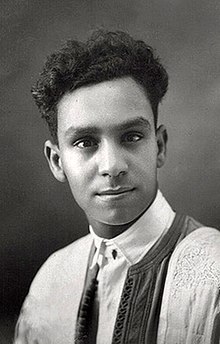Abu al-Qasim al-Shabbi
Abu al-Qasim al-Shabbi ( Arabic أبو القاسم الشابي, DMG Abū l-Qāsim aš-Šābbī , also Abu al-Qasim al-Shabbi ; * February 24, 1909 in Tozeur , Tunisia ; † October 9, 1934 in Tunis ) was a Tunisian poet ; he is widely regarded as the country's national poet . The last two stanzas of the Tunisian national anthem come from his pen. His name is transcribed in many forms, including: Abou el Kacem Chebbi, Aboul Kacem Chabbi, Aboul-Qacem Echebbi, Abou-Al-kacem Ecebbi or Aboul Kacem Chebbi .
Life
Abu al-Qasim al-Shabbi was born in the southern Tunisian oasis town of Tozeur into an educated family of noble origins. His father had studied at the al-Azhar University in Cairo and was a judge ( Qādī ). Through his father's multiple transfers, the young asch-Shabbi got to know the country and its people at an early age. His deep understanding and love for his homeland and its people later found expression in his poems.
In October 1920 he began to study the Koran, religious traditions and mystical poetry at the venerable ez-Zitouna Madrasa in Tunis , followed by a study of Islamic law. He received his attatoui diploma in 1928 and his law diploma in 1930. In the same year, when he was just 21 years old, he married; the marriage had two sons. His father died in October 1929.
Poetic work
Ash-Shabbi's poetic talent showed up early; he wrote his first poems at the age of 14. During his studies, his interest increasingly shifted to modern Arabic and Western poetry. New currents in Arabic poetry from the Middle East and North America fascinated him, as did the European romantics . He frequented literary circles, where he met with rejection with his criticism of the conventions and traditions of Arabic poetry. Like their restrictions, he also tried to break through those of the Tunisian social system and the French colonial regime and demanded social reform, freedom and progress.

Ash-Shabbi's poems cover a wide range of subjects, from nature to patriotism. His revolutionary views found wide resonance among a later generation of Tunisian and Arab nationalists, and his poems were printed in the most influential journals in the Arab world. Asch-Shabbi contributed significantly to the renaissance of Tunisian literature at a time when other Tunisians were starting the social and political renaissance of their society - e. B. Tahir al-Haddad with the groundbreaking work on Tunisian women, and Habib Bourguiba with the founding of his NeoDestour party in the year of Ash-Shabbi's death. Ash-Shabbi broke with traditional forms of Arabic poetry and opened the way for other Tunisian poets to a more emotional poetry that helped pave the way for a social awakening and a modern worldview. Many of his poems were set to music and thus became patriotic or popular songs.
Asch-Schabbi published his first poems at the age of 18. Seven years later he succumbed to his long heart condition. He is called the “poet of life” based on his most famous collection of poems, the “songs of life”. His portrait can be found on the (old) Tunisian 30-dinar banknote and since 2014 on the new 10-dinar banknote.
Publications
- L'imagination poétique chez les Arabes (1929)
- La volonté de vivre (1933)
- Ela Toghat Al Alaam (1934)
- Les chants de la vie (1955)
- Journal (1965)
literature
- Abu al-Qasim al-Shabbi: Selections from the Poetry of Abu Al-Qasim Al-Shabbi (1909–1934): Songs of Life, translated by Lena Jayyusi and Naomi Shihab Nye. Carthage, Tunisia, 1987 (English)
- R. Marston Speight: A Modern Tunisian Poet: Abu al-Qasim al-Shabbi (1909-1934) . In: International Journal of Middle East Studies. Volume 4, No. 2, April 1973, Cambridge University Press, pp. 178-189 (English)
- Abu'l Qasim Ash-Shabbi, I canti della vita, edizione bilingue arabo-italiano, traduzione dall'arabo di Imed Mehadheb, saggio introduttivo e cura di Salvatore Mugno, prefazione di Abderrazak Bannour, postfazione di Aldo Nicosia, Trapani, Di Girolamo Edit , 2008.
Web links
| personal data | |
|---|---|
| SURNAME | Abu al-Qasim al-Shabbi |
| ALTERNATIVE NAMES | Al-Shabbi; Abou el Kacem Chebbi; Aboul Kacem Chabbi; Aboul-Qacem Echebbi; Abou-Al-kacem Ecebbi; Aboul Kacem Chebbi; Abu al-Qasim al-Shabbi |
| BRIEF DESCRIPTION | Tunisian poet |
| DATE OF BIRTH | February 24, 1909 |
| PLACE OF BIRTH | Tozeur , Tunisia |
| DATE OF DEATH | October 9, 1934 |
| Place of death | Tunis |
